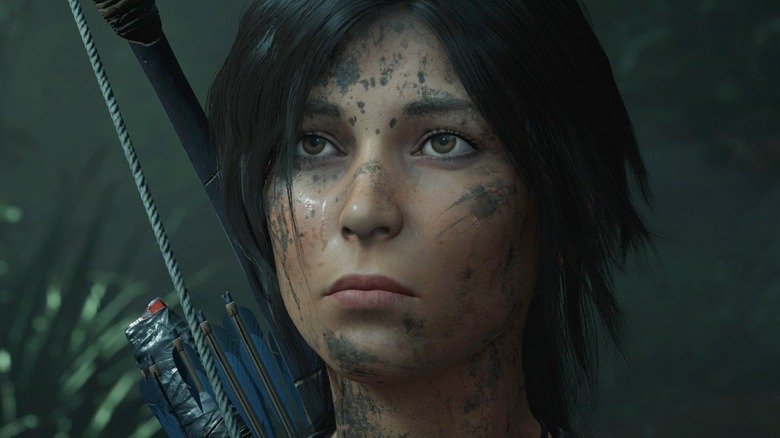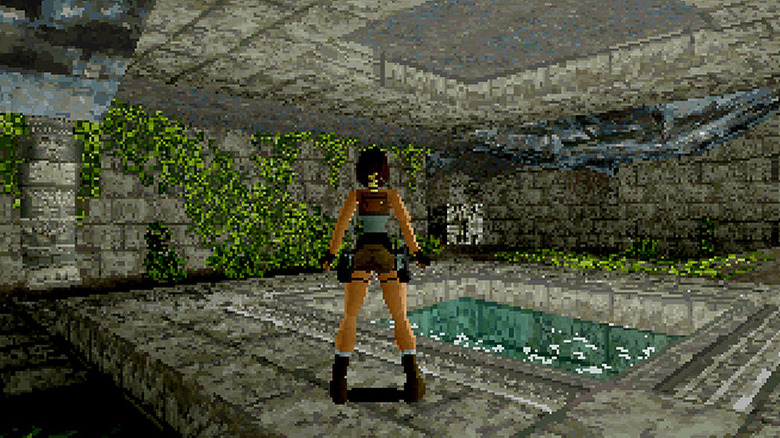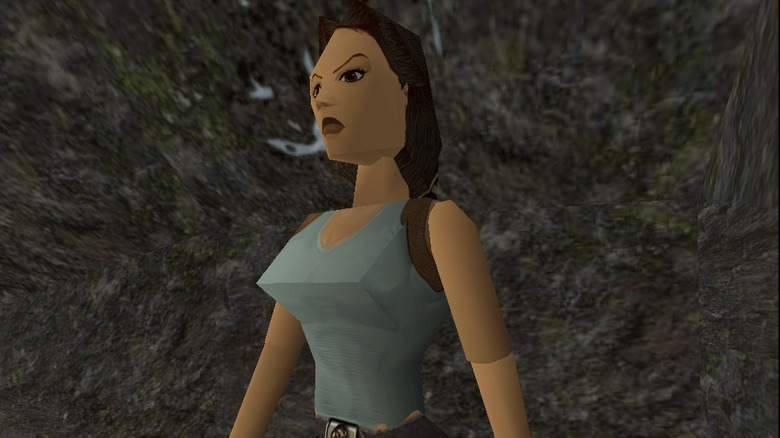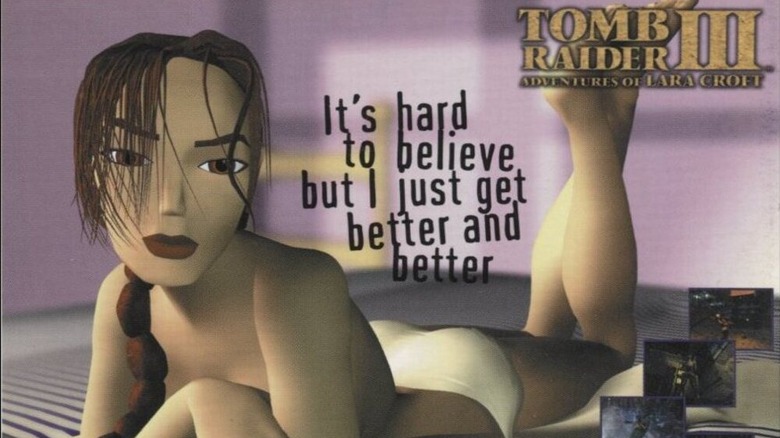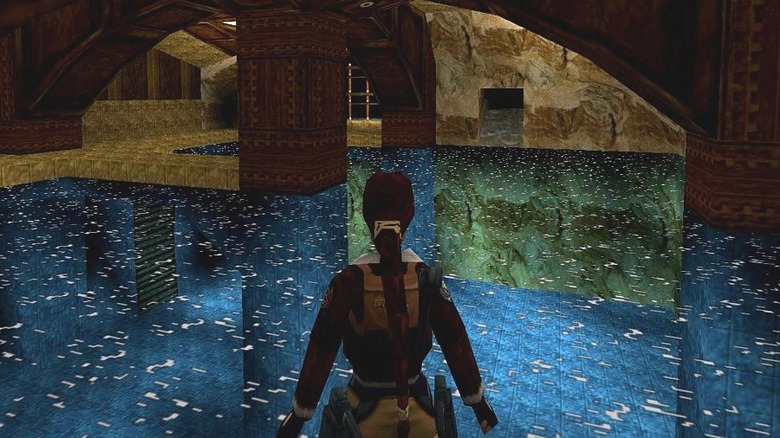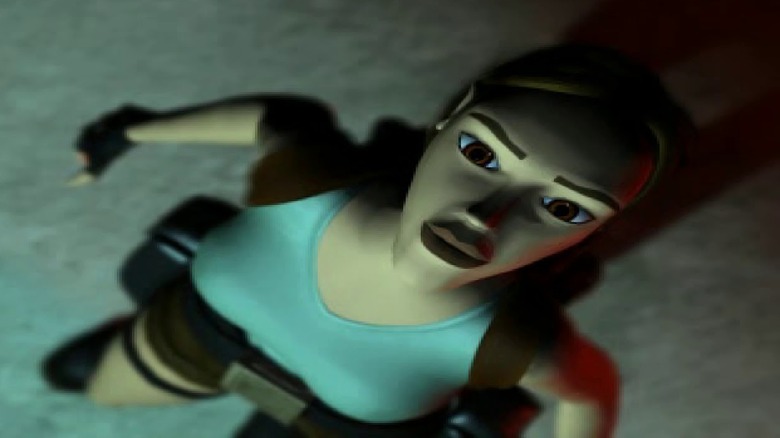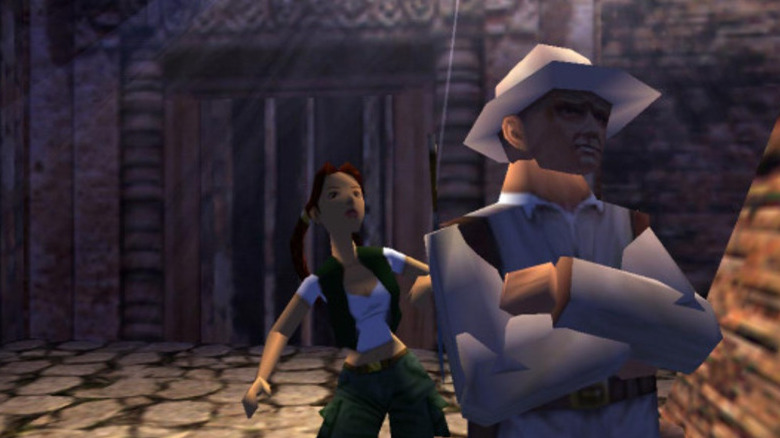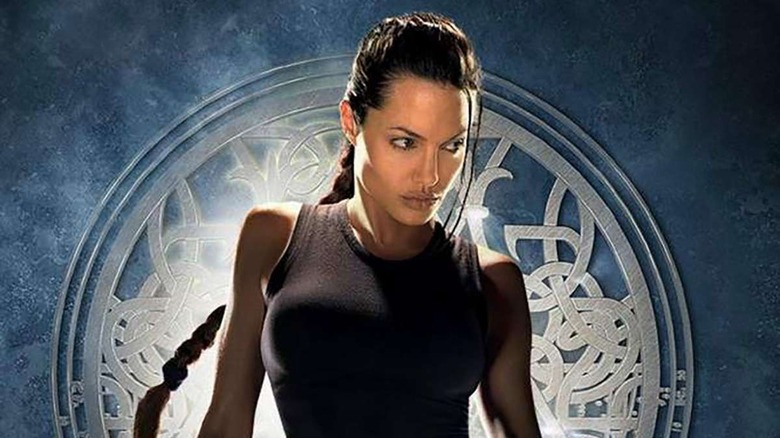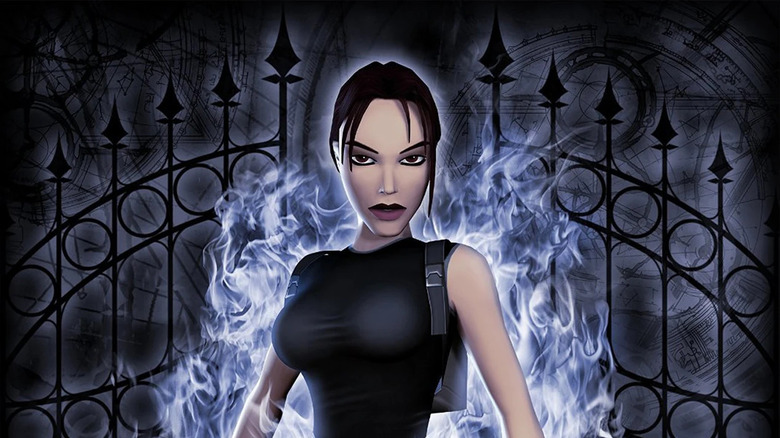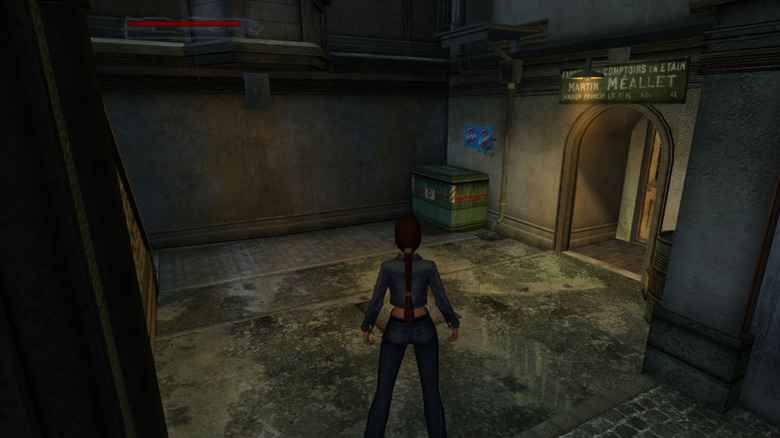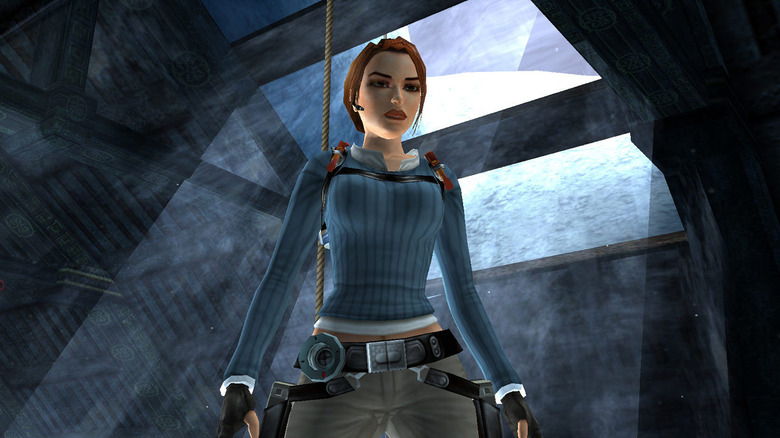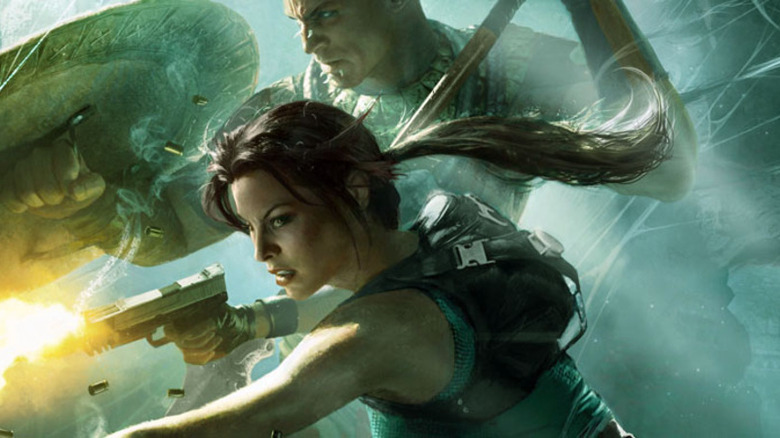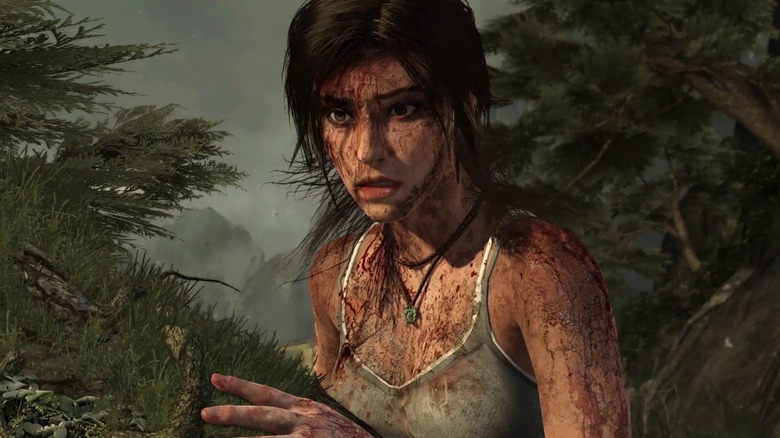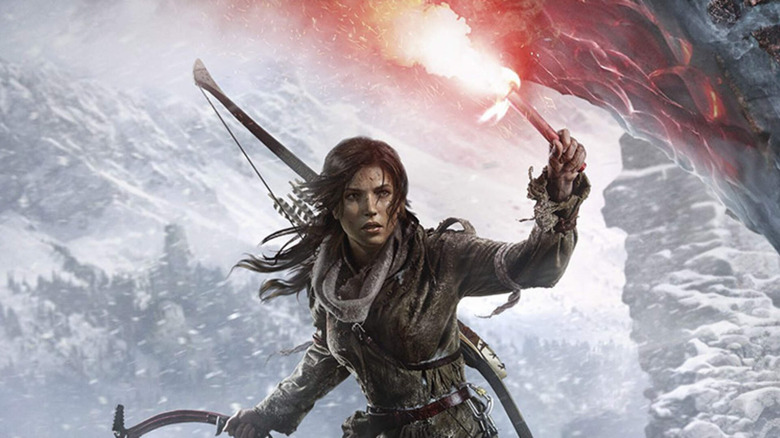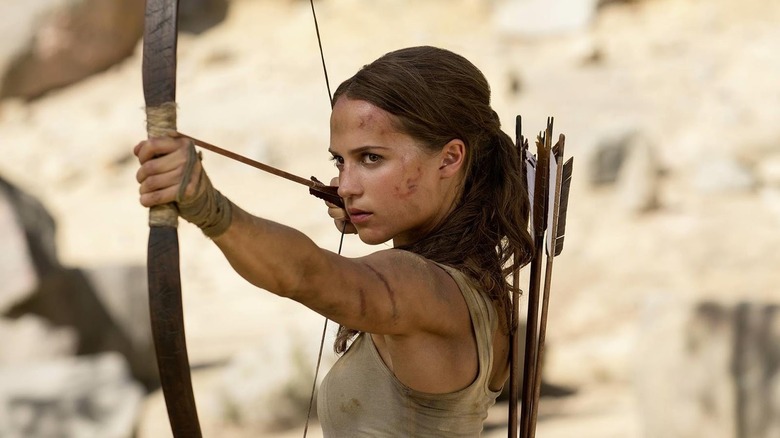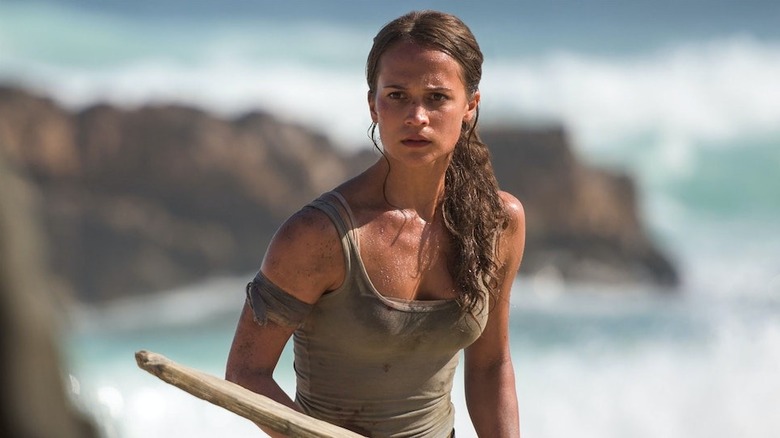The Stunning Transformation Of Tomb Raider
One of the most celebrated action-adventure video game franchises is "Tomb Raider," with its original 1996 installment developed by Core Design and published by Eidos Interactive. Starring throughout the game series is archaeologist and gun-toting adventurer Lara Croft, who explores ancient temples for rare artifacts, battling supernatural monsters and feral creatures dwelling inside. In numerous "Tomb Raider" games, Lara finds herself stopping nefarious figures from misusing these relics to alter the world order, with Lara the best equipped to save the world.
Since the franchise's launch, "Tomb Raider" has released over a dozen video games across a wide array of platforms and inspired a whole wave of merchandising and multimedia adaptations, including three feature films. Along the way, Lara and the "Tomb Raider" franchise has gone through significant changes, adapting to its audience's evolving interests as it repositioned the games for new generations. Here is the evolution of the "Tomb Raider" franchise, from the creation of Lara to its shifting video game and cinematic future.
The road to Lara Croft's creation
The origins of the "Tomb Raider" franchise began with plans by developer Core Design and series creator Toby Gard wanting to create an action-adventure video game in the vein of Indiana Jones, as discussed in a Gametap retrospective. Gard's initial character designs included a rugged male protagonist who wore a jacket and fedora, as a clear visual nod to his fan-favorite source of inspiration. Told by Core founder and CEO Jeremy Heath-Smith that his initial character designs were too derivative of the cinematic archaeologist, Gard focused his designs on creating a female protagonist instead.
Gard's initial concept for this new character was a South American woman named Lara Cruz though this is also modified by management. The Gametap documentary notes that Core Design wanted to appeal more to British audiences, Lara's nationality and ethnicity were changed to make her an English woman under management's direction. According to Gard, the team at Core nicked Lara Croft's name from a local phonebook, going through one until they found a name that fit the character.
Lara's final design takes some cinematic inspiration
Once Core Design settled on a protagonist, they began developing Lara's signature twin pistols and impressive acrobatic gameplay, looking to other classic films for influence. In an interview with a Core Design fan site, "Tomb Raider" programmer and franchise co-creator Paul Douglas recalled artistic and mechanical decisions he and the team made developing the first game. Lara' long braid of hair was replaced with her classic ponytail look, as Douglas felt the physics never looked particularly well for the other hairstyle in motion.
In developing the combat, Lara was given matching pistols to help evoke the balletic gunplay sensibilities of Hong Kong filmmaker John Woo's action movies. Early builds of the original "Tomb Raider" featured a finite amount of ammunition for the guns, rather than the unlimited ammo in the final game. Late in development, wanting to avoid the perception that Lara was ever completely defenseless in the game, the developers gave the pistols infinite ammo rather than program ammo drops to save time.
Tomb Raider's creators left over Lara's exploitative depictions
"Tomb Raider" was an enormous success upon its launch, making the likelihood of a sequel a virtual guarantee, with Core Design immediately diving into development on a follow-up. Two major creative figures behind the first game left Core before work on "Tomb Raider 2" began in earnest: Gard and Douglas (via Eurogamer). In an interview with The Guardian, Gard cites Eidos Interactive's marketing for "Tomb Raider," which depicted Lara in an overly sexual manner, as his primary motivation for leaving his creation behind.
For his part, Douglas observes, in an interview with GameGeek Peeks, that he and Gard were offered either "Tomb Raider 2" or a "Tomb Raider" port for the Nintendo 64 within a tight turnaround time. With neither project appealing to either of them, the two men left Core Design and founded their own game development company, Confounding Factor. It would be nearly a full decade until Gard returned to Eidos and the "Tomb Raider" franchise, albeit under a different development company, with Crystal Dynamics replacing Core (via GameSpot).
Tomb Raider 2 expanded its world and enemies
After Gard and Douglas left Core, it was still full speed ahead for development on "Tomb Raider 2" in order to meet its 1997 holiday release date deadline. For the sequel, the team looked to improve upon the franchise's foundation while propelling the story to new heights for Lara. This lead to a noticeable improvement in technical presentation, with the sequel boasting a new game engine to make Lara appear more natural than in her debut and Core praising the level of detail in an interview with GameSpot.
More than just having Lara fight animals and monsters, "Tomb Raider 2" marked the first time in the franchise Lara killed human enemies, as she was targeted by a sinister cult. In addition to the expansion of enemy types, it was also the first time Lara could operate vehicles. Both of these features continue to play major roles in the franchise moving forward, both in subsequent video games and in the eventual cinematic adaptations, as observed by a retrospective analysis by Polygon.
Tomb Raider: The Last Revelation tried to kill off Lara
With Core having worked virtually nonstop on "Tomb Raider" games since the franchise's debut, the development team became exhausted and experienced franchise fatigue while developing 1999's "Tomb Raider: The Last Revelation." Though the developers doubted this move would stick, "The Last Revelation" concludes with the apparent death of Lara Croft, recounting the game's development in an oral history of "Tomb Raider" conducted by Eurogamer. Co-writer Andrew Sandham initially considered an ending where Lara was decapitated but anticipated that this would have infuriated Core Design CEO Heath-Smith.
"The Last Revelation" ends with a temple under the Great Pyramid of Giza presumably collapsing on Lara while imprisoned by the Ancient Egyptian God of Chaos Set. Heath-Smith was unaware of the game's final cutscene until viewing the completed version and personally reprimanded the development team for killing Lara off. Lara's in-game demise was left more ambiguous, and development on a direct sequel, 2000's "Tomb Raider Chronicles," began shortly thereafter.
The Last Revelation completed Lara's origin story
More than just giving Lara a potential ending, "The Last Revelation" also presented her with an expanded origin story, including a mentor from her mysterious past in Professor Werner Von Croy. The original 1996 game's manual detailed Lara as a young woman disowned by her family for the adventurous lifestyle that she pursued after she survived a plane crash in the Himalayas. "The Last Revelation" featured a prologue that provides a previously untold chapter from Lara's youth prior to this disassociation with her family that informs her adventure in the present.
"The Last Revelation" revealed that, while in boarding school as a teenager, Lara and Von Croy explored an ancient temple in Cambodia that whetted her appetite for action though she nearly died in the process. 15 years later, Lara found herself competing against Von Croy to recover an ancient Egyptian artifact that could end the world as she knows it. This background remained intact for the remainder of the original "Tomb Raider" timeline, with Von Croy appearing in the next two installments.
Tomb Raider arrives on the big screen
In 1998, Paramount Pictures announced that it acquired the cinematic license to produce a "Tomb Raider" film adaptation, which was ultimately released in 2001. Directed by Simon West, "Lara Croft: Tomb Raider" starred Angelina Jolie in the title role alongside a pre-James Bond Daniel Craig. A commercial success, earning over $270 million at the worldwide box office (via BoxOfficeMojo), the film receives a 2003 sequel "Lara Croft: Tomb Raider – The Cradle of Life," with Jolie reprising her role.
However, Jolie very nearly didn't accept the role of Lara Croft at all, initially considering turning the part down when offered. In an interview with Collider, Jolie recalled that she felt the role "didn't suit her" and refused the offer until she was offered the chance to travel the world and train with the British military. Looking back on her experience, Jolie appreciated the opportunity to perform her own stunts and push herself to the limit as she brought the video game character to the big screen. Despite enjoying the experience, Jolie turned down an offer to play Lara a third time, stalling out the film series for 15 years (via IMDB).
Lara's video game return is a public disaster
"The Last Revelation" ended with Lara seemingly crushed by a collapsing temple, though its 2000 sequel "Tomb Raider Chronicles" revealed that Lara's body was never found at the scene, with the gameplay sections largely told in flashbacks. It wasn't until 2003's "Tomb Raider: The Angel of Darkness" on the PlayStation 2 that Lara's survival was explicitly confirmed and she officially made her return alive and well. However, Lara's big comeback was a troubled one behind-the-scenes and jeopardized the future of the video game series and its developer Core Design.
Despite lasting three years, the team recalled in an oral history by Eurogamer that production on "Angel of Darkness" was plagued by poor management, an unmotivated staff, and overly ambitious goals. The game's disastrous reception lead to Heath-Smith departing from Core Design (via GamePro) and Eidos Interactive turning over development on future "Tomb Raider" games to Crystal Dynamics (via BBC). The notoriety surrounding "Angel of Darkness" was so severe that Paramount Pictures publicly blamed the lackluster box office for "Cradle of Life" on the 2003 game disappointing the franchise's fans (via EW).
Angel of Darkness took major cues from other popular games
Among some of the more controversial changes to the franchise made by "Angel of Darkness" was an increased emphasis on stealth gameplay and a more character-driven story than in past installments. In an interview with Edge, lead programmer Richard Morton recalled that management on "Angel of Darkness" wanted to incorporate gameplay elements from "Metal Gear Solid" and "Shenmue" into the franchise. Writer Murti Schofield observed that management felt "Tomb Raider" needed a new direction, leading to more modern locations being used rather than classic tombs.
With such an ambitious scope and change-up in gameplay planned, two locations initially set to be included in "Angel of Darkness" were canceled in the middle of production. These two environments, proposed to be levels set in Germany and Turkey, were saved for a planned sequel "Tomb Raider: The Lost Dominion," per Morton's Edge interview. All of these best-laid plans ultimately lead to nothing as the game's failure led to a soft reboot of the video game series.
Tomb Raider's creator resuscitates the franchise
After founding his own video game company with original "Tomb Raider" Paul Douglas, Toby Gard returned to the "Tomb Raider" franchise following the property being transferred to Crystal Dynamics (via GameSpot). The result of Gard's return was 2006's "Tomb Raider Legend," which served as a soft reboot of the franchise that ignored the previous games' continuity to start relatively fresh. "Legend" kicked off its own trilogy of "Tomb Raider" games, retooling Lara's origin story and giving her a recurring antagonist that appeared in both of the subsequent sequels.
In this rebooted timeline, Lara's mother vanished after interacting with an ancient Nepalese artifact, while it was Lara's father Richard who trained her in archaeology before dying when she was 16. As an adult, Lara becomes obsessed with finding out what happened to her mother while confronting her old friend-turned-enemy Amanda Evert. In an interview with GameTap, Gard explained that he wanted to guide the franchise back to find its way, with "Legend" becoming a commercial and critical success.
Lara delves into arcade-style multiplayer action
2008's "Tomb Raider: Underworld" marked the conclusion of the trilogy that began with "Legend," with the franchise left at another crossroads. Crystal Dynamics decided to experiment with the core gameplay, starting with 2010's "Lara Croft and the Guardian of Light," the first of two spinoff games. In a drastic change from previous games, "Guardian of Light" featured isometric, arcade-style gameplay that allowed for cooperative multiplayer, a first for the franchise.
In an interview with Eurogamer, brand director Karl Stewart observed that the decision not to include the "Tomb Raider" moniker in "Guardian of Light" was a conscious one. The title change was made relatively early in development and meant to demarcate that the resulting game is considered a spinoff between core installments. This spinoff series continued with 2014's "Lara Croft and the Temple of Osiris," which allowed for up to four players to join in on the action together.
Tomb Raider reboots again with an emphasis on realism
In the wake of the poor commercial performance of "Tomb Raider: Underworld," longtime publisher Eidos Interactive was acquired by Square Enix (via Kotaku). Now holding the license to "Tomb Raider" and its development team Crystal Dynamics, Square rebooted the franchise once again with 2013's "Tomb Raider." Publicly announced in 2010, "Tomb Raider" tells a new origin for Lara, while placing an emphasis on survival as the young woman faces harsh conditions after her ship sinks off the coast of Japan.
Early footage from the "Tomb Raider" reboot showcased new gameplay mechanics and a refreshed style, including heightened graphic violence and more realistic combat sequences. Forced to fend for herself, Lara was prone to grievous injury while contending with a mix of human enemies and natural predators as she struggled to survive. A bold new direction for the franchise, 2013's "Tomb Raider" reimagined Lara as a quick-thinking survivalist as she transitions from curious archaeologist to hardened warrior.
Rise of the Tomb Raider completes Lara's evolution
By the end of the 2013 "Tomb Raider" reboot, Lara is irrevocably shaped by her experiences but still not quite the seasoned adventurer that fans knew and loved. That changed with the reboot's 2015 sequel "Rise of the Tomb Raider," which featured a much more competent and capable Lara from the start while leaving room for further growth. "Rise" saw the graphic violence towards Lara mitigated somewhat while improving upon the mechanics from the reboot.
In an interview with Finder, senior designer Michael Brinker explained that Crystal Dynamics wanted to show a less reactive Lara who is better prepared for her latest adventure. At the time, the developers deepened the customization features for players with a variety of skills they could unlock and improve upon. This lead to a greater emphasis on crafting and translation as the more experienced Lara investigates a wintry area deep in Siberia.
Alicia Vikander brings Tomb Raider back to cinemas
After 15 years away from the big screen, Lara Croft's cinematic adaptation was rebooted in 2018, this time with Alicia Vikander starring as the fan-favorite video game protagonist. Plans for a "Tomb Raider" reboot were formally announced in 2011 after GK Films acquires the cinematic license (via The Film Stage), though principal photography didn't officially commence until January 2017 (via Coming Soon). Like the 2013 video game, the new movie focused on Lara's survivalist origins and was considerably darker than either of Jolie's films.
Directed by Roar Uthaug, the filmmaker cast Vikander as Lara for her acting ability, with Uthaug complimenting her in an interview with IndieWire for her commitment to training to get the physicality of her performance down. Uthaug confirmed that he and screenwriter Geneva Robertson-Dworet were both influenced by the 2013 video game reboot, with the two keen to retain elements from it in the film. Though not a success at the domestic box office, "Tomb Raider" earned over $200 million overseas, with a worldwide gross box office total of over $274 million (via BoxOfficeMojo).
Tomb Raider's cinematic future remains at a crossroads
A sequel to "Tomb Raider" was announced in September 2019 and set for a March 2021 release date, with Vikander expected to reprise her role as Lara. Originally scheduled to begin filming in April 2020, the coronavirus pandemic delayed production indefinitely, including plans to film at overseas locations. After joining the production, filmmaker Misha Green turned in a first draft in May 2021, with the working title "Tomb Raider: Obsidian." Vikander still publicly expressed her interest to reprise the role as late as November 2021 (via GamesRadar+).
However, as studio MGM did not put the film in active development by May 2022, it lost the cinematic licensing (via TheWrap), with Vikander vacating the role. Square Enix and GK Films have since opened up a bidding war for the "Tomb Raider" licensing, with the next adaptation anticipated to be another reboot. This change comes with Crystal Dynamics being acquired by the Embracer Group (via IGN), following the announced start of development on a new "Tomb Raider" game in April 2022. No gameplay or story details have currently been divulged.

